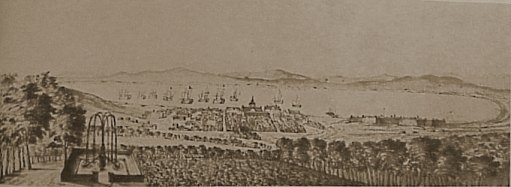The 'Compagnie Tuin'
In the 17th and 18t century the time it took to sail between Europe and Asia, caused a challenge since the knowledge of preserving foods for this time period was not yet manageable. The ships ran out of fresh fruit and vegetables. The smoking and salting of meats even though it helped with the preservation, yet it was not ideal. Sickness and fatalities on board the ships made it imperative for the VOC to look at a supply of fresh fruit and vegetables halfway to the East. The VOC thus established at the Cape a garden which could supply this need. Thus the two key pivotal motives why the Cape became a base for the VOC was the need for a hospital facility and the need to have a garden to provide produce for the ships.
The Council of XVII decided on 25 March 1651 to establish a refreshment station at the Cape: "alsoo bij resolutie van de vergaderinged der seventiene representerende de gemelte generale Oost Indische Compagnie, goet gevonden is, dat (ommme voor te komen dat de gaende ende komende Oost Indische scheepen NA ende van Batavia respective sonder ongeluck de voornoemde caep ofte baij aen doen mitsgaders aldaer komende gelegenheijt mogen vinden omme haer van groente, vleijs, water en andere nootwendigheden aldaer te ververschen ende door middel van dien de siecken op de scheepen sijnde tot haer gesontheijt te brengen nodigh sij) de strant van de gemelte caep begrepen werden."
As early as 29 April 1652 Hendrik Boom was instructed to make a garden, by 19 June five or six men was helping him sowing of plants. However in July most of the seed was washed away.
The garden was surrounded by a ditch eight feet wide and they planted thorn trees beside the ditch to keep out animals and thieves. Hendrik Boom was the chief gardener. By 20 January 1654 van Riebeeck wrote to Batavia that the garden had plenty of cabbage and other vegetables, watermelons, cucumbers etc. The extent of the garden by August 1654, was 5 morgen, the next month they were already harvesting seed from turnips, carrots, beetroot, cauliflower, radish and broccoli. In May 1655 the Cape requested that apple and orange trees be brought from St. Helena to the Cape. It was also also requested that grape vines be brought from Mauritius. In a letter 15 July 1656 van Riebeeck mentioned to the XVII that they had cherry, plum, peach, quince and pear trees in the garden. In 1656 sweet potato from Brazil was planted.
The Company also traded sheep and cattle from the Khoikhoi, thus commenced the expansion of farming with herds and flocks. With animal husbandry they were able to provide themselves and the passing ships with food. Cattle and sheep were obtained from the local Khoikhoi in order to supply the ships. By 1700 the company obtained 116,000 cattle and 37,000 sheep from the Khoikhoi according to van Mil p 82.
The garden was a great success, and assisted the VOC with food and nourishment, in order to maintain the trade between Europe and Asia. Today the garden is still in Cape Town but now it is not used for food supply but as a place where people can enjoy nature and feel refreshed bynature.

BIBLIOGRAPHY AJ Böeseken, Jan van Riebeeck en sy Gesin C Searle, The History of the Development of Nursing in South Africa 1652 - 1960: A Socio-Historical Survey, (Struik, 1965) P van Mil, De VOC in de Kaart gekeken 1602 - 1799
- Hits: 11901
